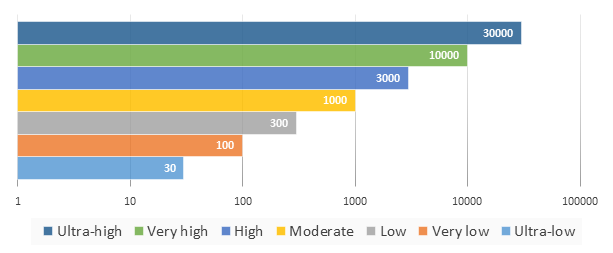Defining “Low GWP”
written by Pavel Makhnatch (under supervision of Rahmatollah Khodabandeh and Björn Palm)
As many refrigerants are strong greenhouse gases, the use of the refrigerants with low global warming potential (GWP) is seen as a way to minimize the effect of the refrigeration systems on the global warming. However, how low GWP value should the low GWP refrigerant have?
Refrigerants differ greatly in terms of their global warming potential. Some refrigerants have very low GWP values of from 0 to 7 (Ammonia, CO2, R290, R1234yf), some a bit higher (R152a, R32). There are also refrigerants with greater GWP values of, for instance 1430 (R134a) and 2088 (R410A). Which of the above listed are “low GWP” refrigerants?
150 as an indicative GWP value for “low GWP”
More than 6 years ago EU has come out with the Directive, which set the limit on GWP value of refrigerant to be used in mobile air conditioning (MAC) systems [1] and thus promoted the use of the refrigerants with low GWP. Although no definition of “low GWP refrigerant” is given by the Directive, it has become publically accepted that “low GWP refrigerants” are those with GWP of no greater than 150. This limit allows one to choose from a number of potential refrigerants, including natural CO2, new synthetic R1234yf and conventional R152a, which seemed to be the one that dictated the final value of 150. New F-gas Regulation proposal is using the threshold GWP value of 150 in some parts of the regulation as well [2].
The industry reacted to new legislations by increased development in area of low GWP refrigerants: both for MAC systems and for other refrigeration systems. While it was possible to find suitable low GWP replacement for R134a, for other common refrigerants like R410A and R404A alternatives with GWP of lower than 150 by far could not be easily found (apart from natural refrigerants CO2 and HCs, which will then require significant system redesign to be used), as it is indicated at the Figure 1 [3]. This indicates that the GWP of 150 is probably not a perfect threshold value for refrigerants to be referred as “low GWP” ones.

“Low” or “very low”
The simple Google search on “Low GWP refrigerants” gives us around a hundred thousand results. While the term is widely used today, the strong interest to low GWP refrigerants arose just a few years ago. At the beginning, the discussion around this topic seemed to be held mainly by the main chemical production companies: researchers from Daikin discussed R32 as a promising “low GWP refrigerant” in the air conditioning field [4], their colleagues from Honeywell presented an “Update on an ultra-low GWP refrigerant” use [5], DuPont presented its refrigerant with “very low GWP” [6]. Note the use of the ultra-low, very low and low terms during that time.
The fact that no clear definitions of “low GWP” and “high GWP” are available was indicated by United Nations Environment Programme (UNEP) in its previous progress report [7]. There it was discussed, that the terms themselves are of comparative nature, and therefore needs to be related to some mean GWP value. The medium value for a range of refrigerants was estimated to be slightly greater than 2000 and a classification, as presented at Figure 2, has been suggested. This classification did not become standard by this time and UNEP itself is mostly using three comparative terms – “low”, “medium” and “high” GWP - in its new report [8].

“Medium” GWP refrigerants would reduce confusion
The recent Ecodesign Regulation proposal have raised the bar for the low GWP value by proposing lower minimum efficiency requirement for a selected equipment which uses refrigerants with GWP 675 or less [9]. “The GWP threshold of 675 kg CO2 eq. is proposed in the preparatory study on air conditioning. It originates from the GWP of the refrigerant R-32. Of the low GWP refrigerants, R-32 is the one with the highest GWP. It could become an interesting alternative to R-410A and R-407C, since it has a low GWP and a possible performance increase”, explains the European Commission [10].
Because of the absence of an agreement in definition of “low GWP” term, the confusion is often arise when dealing with new environmentally friendly refrigerants. Perhaps, it would be easier to level the refrigerants if low/high GWP range would be clearly defined and, perhaps, extended to include medium GWP refrigerant range.
Works Cited
| [1] |
European Parliament, "Directive 2006/40/EC of the European Parliament and of the council," Official Journal of the European Union, 2006. |
| [2] |
European Commission, "Proposal for a regulation of the European Parliament and of the council on fluorinated greenhouse gases," Brussels, 2012. |
| [3] |
K. Amrane, Overview of AHRI Research on Low-GWP Refrigerants, 2013. |
| [4] |
R. Yajima, K. Kita, S. Taira and N. Domyo, "R32 as a solution for energy conservation and low emission," in International Refrigeration and Air Conditioning Conference, Purdue, 2000. |
| [5] |
M. Spatz, "Update on an ultra-low GWP refrigerant for mobile air conditioning applications," Alternative Refrigerant Systems Symposium, 2006. |
| [6] |
Green Car Congress, "DuPont Refrigerants Unveils First DP-1 Refrigerant Test Car in Germany," 29 Nov 2006. [Online]. Available: http://www.greencarcongress.com/2006/11/dupont_refriger.html. |
| [7] |
UNEP, TEAP 2010 progress report. Volume 1., 2010. |
| [8] |
UNEP, "Report of the technology and economic assessment panel. Volume 1.," 2013. |
| [9] |
European Commission, draft Ecodesign Regulation: working document on possible requirements for air heating products, cooling products and high temperature process chillers, 2013. |
| [10] |
European Commission, Explanatory Notes: working documents on possible requirements for air heating products, cooling products and high temperature process chillers, 2013. |
